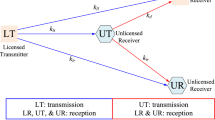Abstract
This paper studies a new decode-and-forward cooperative overlay cognitive radio non-orthogonal multiple access (DFCO-NOMA) system, where a secondary network shares the license spectrum of a primary network by using NOMA principles. Asymptotic expressions for the outage probability in high signal-to-noise ratio regime of both secondary and primary destinations are derived assuming channel estimation error (CEE) and imperfect successive interference cancellation. The diversity order for the primary and secondary symbols are also derived. Further, the optimal power allocation coefficients to maximize the system throughput are determined to ensure priority to the primary network. The paper also investigates the impact of various parameters such as power allocation coefficients, CEE, and detection threshold, on the outage performance of the proposed system. The accuracy of derived analytical results are verified through the Monte Carlo simulations.






Similar content being viewed by others
References
Ding, Z., et al. (2017). A survey on non-orthogonal multiple access for 5G networks: Research challenges and future trends. IEEE Journal on Selected Areas in Communications, 35(10), 2181–2195.
Chen, Z., Ding, Z., Dai, X., & Zhang, R. (2017). An optimization perspective of the superiority of NOMA compared to conventional OMA. IEEE Transactions on Signal Processing, 65(19), 5191–5202.
Diamanti, M., Fragkos, G., Tsiropoulou, E. E., & Papavassiliou, S. (2020). Unified user association and contract-theoretic resource orchestration in NOMA heterogeneous wireless net-works. IEEE Open Journal of the Communications Society, 1, 1485–1502.
Vamvakas, P., Tsiropoulou, E. E., Papavassiliou, S., & Baras, J. S. (2017). Optimization and re-source management in NOMA wireless networks supporting real and non-real time service bundling. IEEE Symposium on Computers and Communications (ISCC), 2017, 697–703. https://doi.org/10.1109/ISCC.2017.8024609.
Ding, Z., Peng, M., & Poor, H. V. (2015). Cooperative non-orthogonal multiple access in 5G systems. IEEE Communications Letters, 19(8), 1462–1465.
Kim, J.-B., & Lee, I.-H. (2015). Capacity analysis of cooperative relaying systems using non-orthogonal multiple access. IEEE Communications Letters, 19(11), 1949–1952.
Zhang, J., Dai, L., Jiao, R., Li, X., & Liu, Y. (2016). Performance analysis of relay assisted cooperative non-orthogonal multiple access systems. Retrieved October 5, 2020, from http://oa.ee.tsinghua.edu.cn/dailinglong/publications/paper.
Li, Y., Li, Y., Chen, Y., Ye, Y., & Zhang, H. (2018). Performance analysis of cooperative NOMA with a shared AF relay. IET Communications Journals, 12(19), 2438–2447.
Lv, L., Chen, J., Ni, Q., Ding, Z., & Jiang, H. (2018). Cognitive non-orthogonal multiple access with cooperative relaying: A new wireless frontier for 5G spectrum sharing. IEEE Communications Magazine, 56, 188–195.
Jia, M., Wang, X., Guo, Q., Ho, I.W.-H., Gu, X., & Lau, F.C.-M. (2019). Performance analysis of cooperative non-orthogonal multiple access based on spectrum sensing. IEEE Transactions on Vehicular Technology, 68(7), 6855–6866.
Lv, L., Chen, J., & Ni, Q. (2016). Cooperative non-orthogonal multiple access in cognitive radio. IEEE Communications Letters, 20(10), 2059–2062.
Lv, L., Yang, L., Jiang, H., Luan, T. H., & Chen, J. (2018). When NOMA meets multiuser cognitive radio: Opportunistic cooperation and user scheduling. IEEE Transactions on Vehicular Technology, 67(7), 6679–6684.
Wang, X., Jia, M., Guo, Q., Ho, I.W.-H., & Lau, F.C.-M. (2019). Full-duplex relaying cognitive radio network with cooperative non-orthogonal multiple access. IEEE Systems Journal, 13(4), 3897–3908.
Zhang, X., et al. (2019). Outage performance of NOMA-based cognitive hybrid satellite-terrestrial overlay networks by amplify-and-forward protocols. IEEE Access, 7, 85372–85381.
Singh, V., Upadhyay, P. K., & Lin, M. (2020). On the performance of NOMA-assisted overlay multiuser cognitive satellite-terrestrial networks. IEEE Wireless Communications Letters, 9(5), 638–642.
Le, Q. N., Yadav, A., Nguyen, N. P., Dobre, O. A., & Zhao, R. (2021). Full-duplex non-orthogonal multiple access cooperative overlay spectrum-sharing networks with SWIPT. IEEE Transactions on Green Communications and Networking, 5(1), 322–334.
Le, A. T., Ha, N. D. X., Do, D. T., Yadav, S., & Lee, B. M. (2021). Enabling NOMA in overlay spectrum sharing in hybrid satellite-terrestrial systems. IEEE Access, 9, 56616–56629.
Zhao, J., Yue, X., & Kang, S. (2020). Performance analysis of a relaying assisted NOMA system with imperfect CSI and SIC. Physical Communication Journal, 43, 101197.
Zhao, J., Yue, X., Kang, S., & Tang, W. (2021). Joint effects of imperfect CSI and SIC on NOMA based satellite-terrestrial systems. IEEE Access, 9, 12545–12554.
Arzykulov, S., Tsiftsis, T. A., Nauryzbayev, G., & Abdallah, M. (2019). Outage performance of cooperative underlay CR-NOMA with imperfect CSI. IEEE Communication Letters, 23(1), 176–179.
GyeongraeIm, & Lee, J. H. (2019). Outage probability for cooperative NOMA systems with imperfect SIC in cognitive radio networks. IEEE Communication Letters, 23(4), 692–695.
Liping, L., Li, Q., & Cheng, J. (2020). Performance analysis of overlay cognitive NOMA systems with imperfect successive interference cancellation. IEEE Transactions on Communications, 68(8), 4709–4722.
Singh, S., & Bansal, M. (2021). Performance analysis of NOMA-based AF cooperative overlay system with imperfect CSI and SIC. IEEE Access, 9, 40263–40273.
Yang, Z., Ding, Z., Fan, P., & Karagiannidis, G. K. (2016). On the performance of non-orthogonal multiple access systems with partial channel information. IEEE Transactions on Communications, 64(2), 654–667.
Kay, S. M. (1993). Fundamentals of statistical signal processing: Estimation theory. PTR Prentice Hall.
Yang, Z., Ding, Z., Fan, P., & Al-Dhahir, N. (2016). A general power allocation scheme to guarantee quality of service in downlink and uplink NOMA systems. IEEE Transactions on Wireless Communications, 15(11), 7244–7257.
Author information
Authors and Affiliations
Corresponding author
Additional information
Publisher's Note
Springer Nature remains neutral with regard to jurisdictional claims in published maps and institutional affiliations.
Rights and permissions
About this article
Cite this article
Singh, S., Bansal, M. On outage analysis of cooperative overlay NOMA system with CEE and imperfect SIC. Wireless Netw 27, 4987–4995 (2021). https://doi.org/10.1007/s11276-021-02784-y
Accepted:
Published:
Issue Date:
DOI: https://doi.org/10.1007/s11276-021-02784-y




